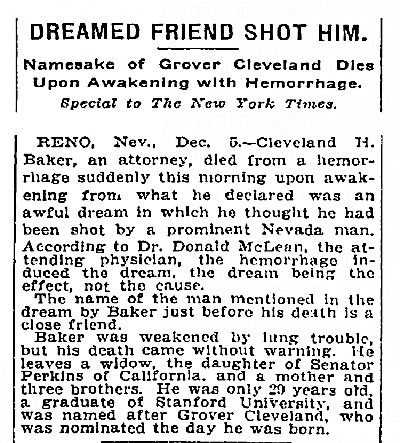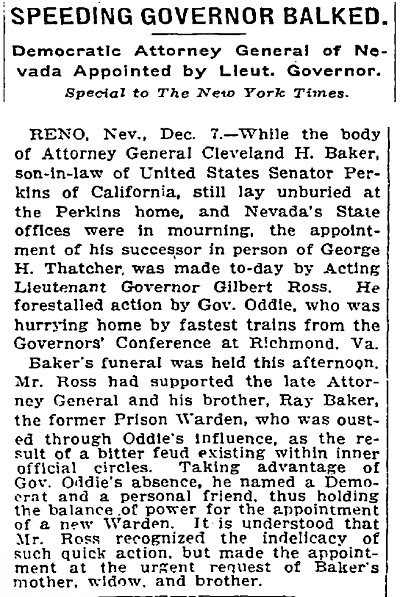15th Nevada Attorney General
Term: January 2, 1911 - December 5, 1912
[Died in
Office]
Biography
Cleveland Hall Baker, born in Eureka,
Nevada, on June 26, 1883, was the son of early Nevada pioneers G.W. and Mary A.
Baker. Baker graduated from the public schools of Oakland, California; Belmont
Academy, Belmont, CA; and Leland Stanford Jr. University with an A. M. (
artium
magister) degree (known today as a Master of Arts degree).
After graduation, Baker worked for a short
time in the newspaper industry in San Francisco. He studied law there and
in Reno, Nevada, and began his practice of law in the gold-silver boom-town and
labor-strafed town of Tonopah, Nevada. The Nye County District Attorney
appointed Baker as Nye County’s Assistant District Attorney, and in 1908, voters
elected him as their District Attorney.
On November 18, 1908, in Oakland,
California, Baker married Pansy Perkins, the daughter of California US. Senator
George C. Perkins. In 1910, voters elected Baker as the Nevada Attorney
General.
Election of 1910
Elected as Nevada’s 15th Attorney General
on November 8, 1910, Baker (Democrat) received 9773 (50.2%) of the 19,481 votes
cast, and George Springmeyer (Republican) received 9,708 (49.8%) votes.
Office
Administration and Duties
Mr. Baker’s office staff consisted of
former Nevada Attorney General James R. Judge as Deputy Attorney General and Ms.
Irene Barkley as Stenographer[1],
according to the Nevada Attorney General’s budget for the 1911–1913 state
biennial fiscal period:
1911–1913 Budget
|
$16,200
|
|
$ 4,000
|
Attorney General’s Salary
|
|
$ 5,000
|
For salary of the Attorney General
as ex officio Mineral Land Commissioner, $5,000
|
|
$ 4,800
|
Deputy Attorney General’s Salary
|
|
$ 2,400
|
Stenographer’s Salary
|
|
|
For current expenses for telegraph,
postal, and contingent expenses for the State officers, Supreme Court,
and State Library, and for transportation of State property, $10, 000
|
The 1911 Nevada State Legislature did not
pass any statutes adding duties and responsibilities for the Attorney General.
The 1912 Special Session of the Nevada State Legislature (February 23-29, 1912)
focused on tax and related financial issues and did not address the duties of
the Nevada Attorney General.
Epilog
Mr. Baker, at almost 30 years old, died
while in office on December 5, 1912. Although his burial took place in
Oakland, California, his death caused a regional sensation and gained national
attention. From the San Francisco Call, Volume 113, Number 6, 6
December 1912:
DREAM IS FATAL TO
C.H. BAKER, RENO POLITICIAN - Nevada Attorney General, Dreaming He Is Being
Slain By Banker, Suffers Hemorrhage.
With details that
shocked hosts of his friends throughout the bay cities and on the peninsula,
news of the death in Carson City yesterday morning of Cleveland H. Baker,
attorney general of Nevada and son-in-law of United States Senator George C.
Perkins, was received in San Francisco last night.
Baker died of
internal hemorrhage, produced from the effects of a terrible dream early
Thursday morning, in which he believed he was the victim of a bullet fired into
his body by George Wingfield, multi-millionaire president of the Nevada
Consolidated Gold Mining Company and president of several Nevada banks.
So vivid was the
nightmare that Baker awoke in a highly excited condition, and told his wife, who
was Miss Pansy Perkins, of his awful fancies. She quieted him, and he went
to sleep, unaware that he was slowly bleeding to death. Shortly after 9
o’clock he was awakened and commenced to dress. Stooping over to lace his shoes,
he was suddenly stricken with exhaustion and fell to the floor. Mrs.
Baker, unsuspecting anything more severe than a fainting spell, rushed to the
central office on the telephone company a few doors distant in order to avoid
alarming her husband by a call for help, and summoned a physician. Although a
doctor responded almost immediately, by the time he arrived, Baker was beyond
medical aid. He died a few minutes later without regaining consciousness.
The physician
stated that Baker, in the wild flight of his imagination, ruptured a small
artery, which had developed into a hemorrhage when he stooped to lace his shoes.
The news of Baker's death caused a profound shock in Carson City, Reno.
Continued on Infer[sic] 2, Column 6
C. H. BAKER, RENO
POLITICAL LEADER, KILLED BY DREAM Attorney General, Imagining George Wingfield
Seeks His Life, Dies Of Hemorrhage
Continued From Page 1
. . . and
elsewhere in Nevada. All flags in Carson were at half-mast[sic] during the
day and will remain so until after the funeral, and the state offices will be
closed on that day.
At 7:30 o'clock
last night the body was put aboard a train for Oakland, the remains being
accompanied by his widow, his mother, Mrs. George W. Baker, and his two
brothers, Raymond T. Baker, former prison warden of Nevada, and Harry L. Baker
of Reno. He also has a brother in Oakland, George W. Baker Jr., and a
sister living in Piedmont, Mrs. J. D. Grissim. The funeral will be held in
that city, where Baker was prominent socially. GRADUATE OF STANFORD '04
Baker was born in Eureka, Nev., and was 28 years old. He lived in Reno as
a boy and was educated in the public schools there and at Belmont Academy, near
San Mateo. He was graduated from Stanford University in 1904, where he was
president of the Varsity Glee club, "stunt" man, intercollegiate tennis player,
a member of the Zeta Psi fraternity and socially and fraternally one of the best
known collegians of his time. His marriage to Miss Pansy Perkins was one
of the big social events of the year. After studying law in Reno and San
Francisco he went to Tonopah, where he was successful in 1908 in a campaign on
the democratic ticket for district attorney of Nye County. Two years later
he was nominated for attorney general and was elected by a great majority.
In that office he has made a record for efficient performance of duty that
gained him wide popularity throughout the state.
Baker’s father,
George W. Baker, practiced law in San Francisco for many years, and his
grandfather, the late Colonel David H. Hall, was a pioneer of the state of
Nevada. As Baker's term of office did not expire until January, 1915, the
question of appointing a successor will probably await the return of Governor
Oddie from the governors’ conference at Richmond, Va.
An odd reference to Mr. Baker’s death
appears in a December 6, 1912, article published in THE NEW YORK TIMES
(see Figure 1).[2]
Another reference to Mr. Baker’s death appears in a December 8, 1912, article
published in THE NEW YORK TIMES (see Figure 2).[3]

Figure
1
:
THE NEW YORK TIMES, Friday, December 6, 1912

Figure 2
:
THE NEW YORK TIMES, December 8, 1912
[1] Statutes of Nevada, 1911, p. XXXI.
[2] “Dreamed Friend Shot Him. Namesake of
Grover Cleveland Dies Upon Awakening With Hemorrhage.” New York
Times [Reno NV] 6 Dec. 1912: n. pag. Online.
[3] “Speeding Governor Balked. Democratic
Attorney General of Nevada Appointed by Lieut. Governor.” New York
Times [Reno NV] 8 Dec. 1912. Web: n. pag.